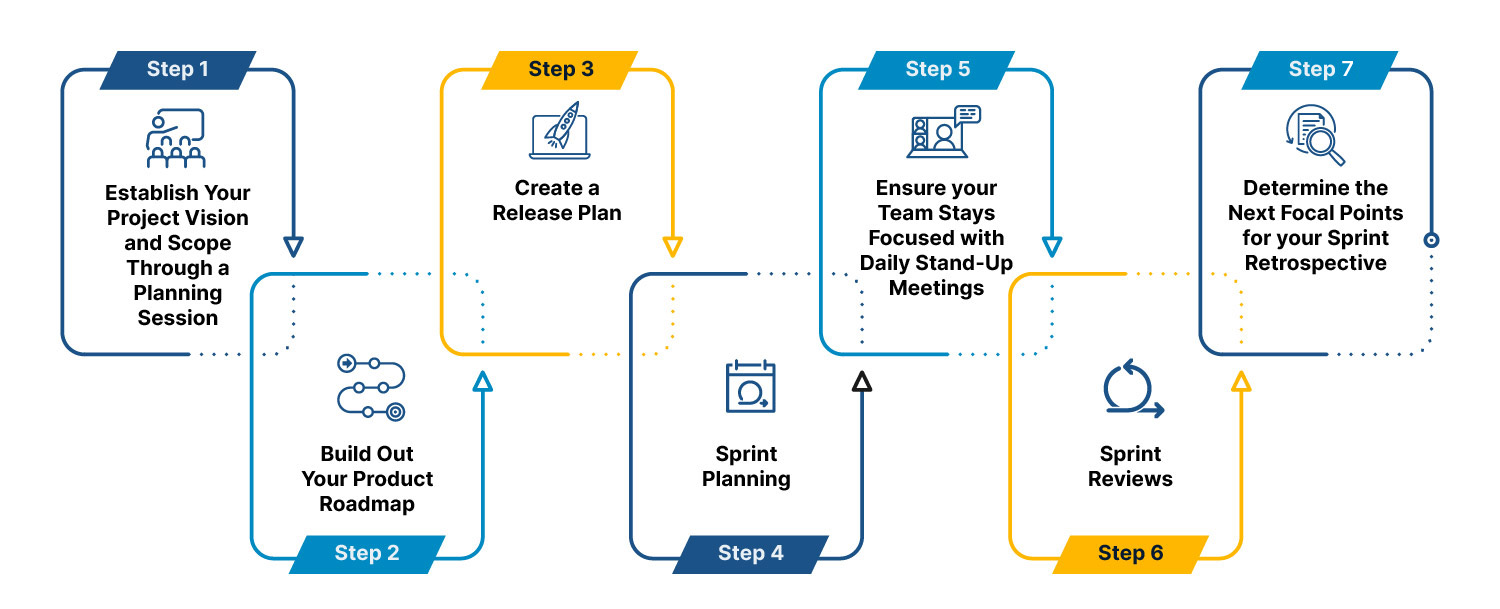Agile methodology involves an iterative and time-bound approach to software delivery, focusing on incremental development from project inception rather than a single final release. It operates by dividing projects into smaller user stories, prioritizing them, and continually delivering them in short two-week cycles known as iterations.
Agile project management steps encompass methodologies such as Scrum and Kanban, emphasizing adaptive, simultaneous workflows in contrast to the linear structure of Waterfall. The key principles of Agile project management prioritize individuals, prototypes, collaborations, and iterative improvements.
The 4 Core Principles of Implementing Agile Project Management:
Fundamentally, Agile project management steps are more of a philosophy than a strict methodology. This implies that although there are numerous approaches to applying Agile, they all share certain fundamental principles that distinguish them from the Waterfall method:
- Prioritizing individuals and interactions over processes and tools
- Emphasizing working software over extensive documentation
- Promoting customer collaboration over rigid contract negotiation
- Encouraging responsiveness to change over rigidly following a plan.
Roles of Agile Methodology Implementation:
Agile project management steps introduce several new team roles that might be unfamiliar. Although the specifics may vary among different Agile methodologies, the key roles to be aware of are as follows:
- Scrum Master: Responsible for ensuring the smooth progression of each sprint by monitoring progress, facilitating meetings, and eliminating obstacles. They serve as the team's advocate and communicate with stakeholders.
- Product Owner: Plays a pivotal role in defining sprint goals, managing the backlog, and representing the user's perspective to the team. This position can be held by the project manager or another designated individual.
- Team Members: Engaged in executing the tasks determined for each sprint. Agile teams are self-organizing, making their own decisions on how to best achieve their objectives rather than being directed by external parties.
- Stakeholders: Comprise individuals or groups with a vested interest or involvement in the project. They may include end-users, customers, management, or other relevant parties. Stakeholders provide input, help establish priorities, and participate in the project through regular interactions with the Product Owner and the team.
Agile Methodology Implementation Process:
How to pick the Agile methodology that’s right for your team.
- Agile project management with Scrum
- Kanban
- Extreme programming
- Lean method
Once the product vision is set and teams embrace agile principles, the organization must choose a process methodology. The main ones are Scrum and Kanban. Some prefer starting with Kanban as it's easy to understand and implement. In Kanban, teams pull user stories from a board and move them through a workflow until they're done.
1. Agile with scrum

What happens after the sprint retrospective?
Scrum is a management and control process that simplifies complexity and focuses on creating software that fulfills business requirements. It uses two-week sprints for work, which are planned, executed, and reviewed at the end. The team collaboratively manages tasks from a sprint backlog.
Additionally, daily 15-minute Scrum meetings help the team discuss any obstacles, review previous work, and plan upcoming tasks to ensure synchronization and teamwork.
2. Kanban:
Kanban is a visual project management approach used to streamline tasks and enhance project efficiency. It centers around the Kanban board, either physical or digital, which divides project phases into columns. Tasks are represented on cards that progress through each column until completion.
Kanban is associated with various advantages. It improves project transparency by visually highlighting pending tasks and identifying bottlenecks. This visual representation facilitates resource allocation, reducing inefficiencies. According to the 2022 State of Kanban Report, the key benefits of Kanban include:
- Improved visibility of flow
- Increased speed of delivery or throughput
- Improved predictability
- Better coordination between business goals, key results, and task execution.
Kanban integrates principles from both Agile and Lean methodologies. It can be seamlessly combined with other approaches and is frequently utilized alongside Scrum in a hybrid method known as Scrum ban. According to the 2022 State of Agile report, 27% of participants were implementing agile project management ban, while 56 percent were employing Kanban.
Extreme Programming:
The main goal of Extreme Programming (XP) is to enhance software product quality and adaptability to evolving customer demands.
Extreme Programming enhances software quality through the following approaches:
- Planning: The project is segmented into iterations, with each iteration involving planning, defining user stories, and creating a release schedule for frequent, small feature releases.
- Management: Each team member is assigned specific tasks and participates in daily stand-up meetings to track project velocity.
- Design: Tasks are broken down, and the testing framework is finalized.
- Coding: Coding follows established principles and focuses on delivering required functionality, followed by thorough unit testing and end-of-iteration reviews.
- Testing: Code is subjected to unit testing before it is eligible for release.
Lean Method:
Lean development involves the removal of unnecessary elements.
Key principles of Lean methodology include:
- Eliminating waste: This entails getting rid of unnecessary code, delays, maintaining prioritization, ensuring code quality and standards, and effective communication.
- Building quality: Focus is on preventing the creation of defects rather than just reducing them.
- Writing minimal code: Emphasis is placed on concise and effective coding.
- Creating knowledge: Inspired by lean manufacturing, it promotes simplified, standardized production with minimal alterations, fostering the creation of knowledge.
- Deferring commitment: Encourages managing unforeseen obstacles by allowing room for improvement until all uncertainties are addressed.
- Early delivery: Prioritizes building and launching a Minimum Viable Product quickly, focusing on rapid delivery with essential features.
- Team respect: Cultivates a cooperative environment by maintaining a balanced project atmosphere.
- Optimization: Emphasizes focusing on the value stream as a whole, minimizing delays, disruptions, and miscommunications.
How to Measure Your Team's Success Through Agile Project Management:
Agile promotes making decisions based on measured data and empirical validation. As an Agile leader, your aim is to enhance the value your organization delivers swiftly. Traditionally, organizations linked value with outputs, assuming they predict outcomes, but real experience suggests a more complex picture.
Agile success is measured at different levels: Team, Portfolio, and Organization. At the team level, two common problems arise when measuring Agile teams: the wrong people are doing the measuring, and the wrong things are being measured.
For organizations already on the Agile path, these team success measures will help guide your Agile journey.
Conclusion:
Implementing the Agile methodology involves more than a singular method or process for software development. It encompasses various methods under one umbrella. Agile methods have demonstrated their worth by enhancing profits by over 35% and revenue by over 30% on average, compared to non-practicing companies. In the swiftly evolving software industry, Agile enables greater flexibility, simplicity, and agility, leading to increased productivity and the delivery of innovative products.













